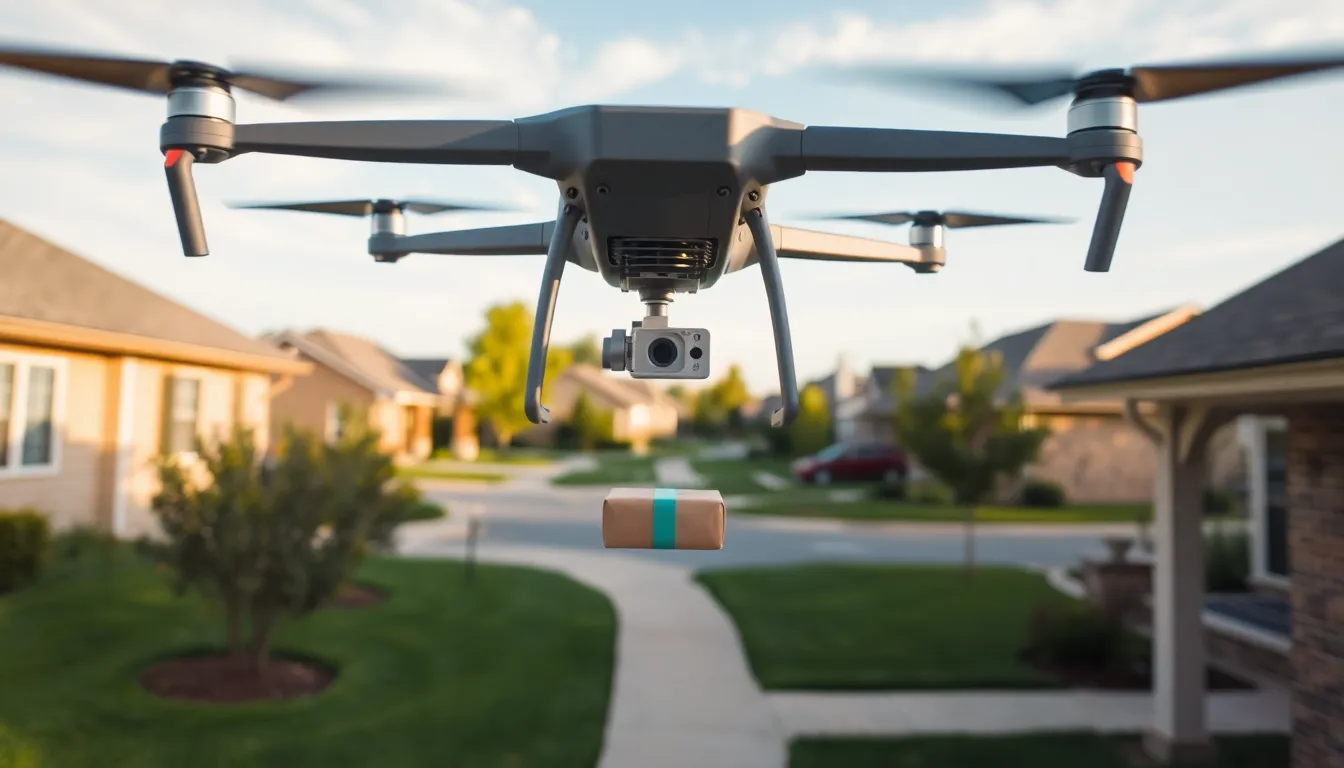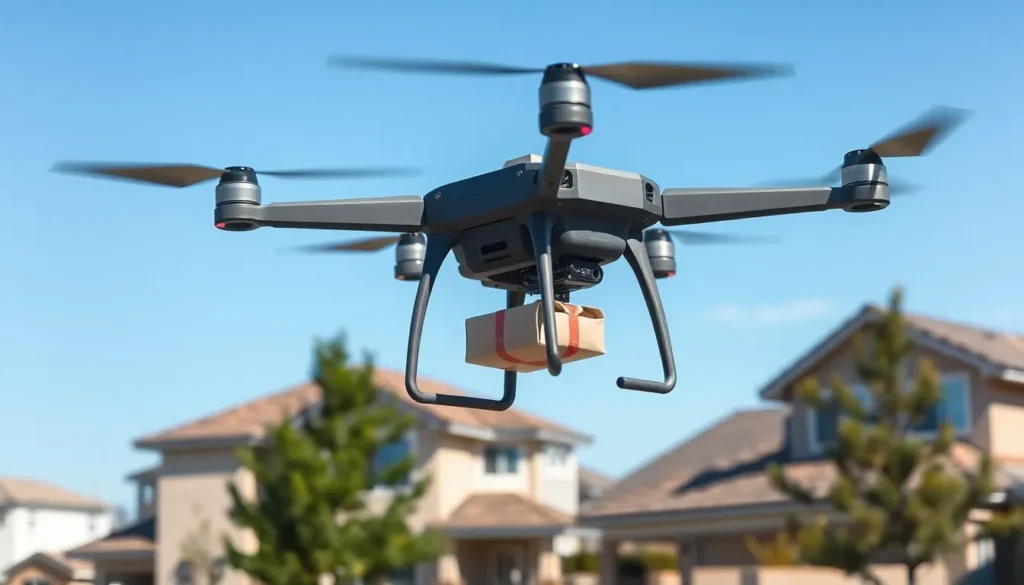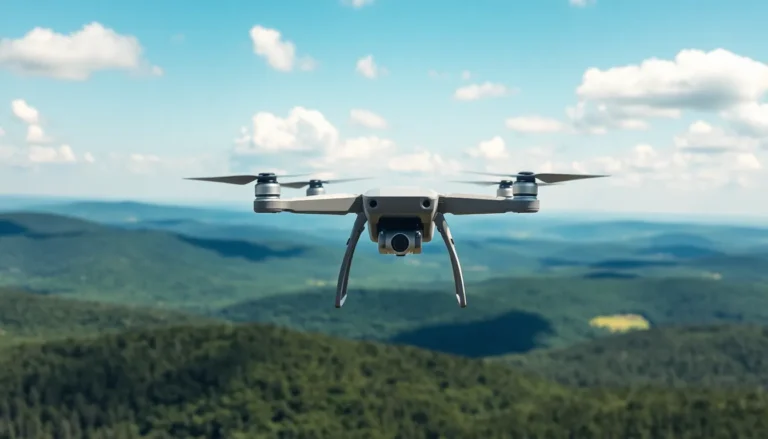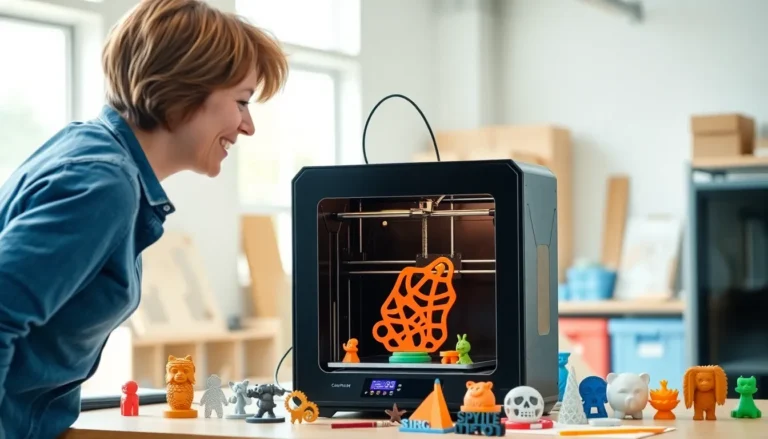Imagine a world where your pizza arrives faster than you can say “extra cheese.” Welcome to the age of drone delivery, where flying robots are revolutionizing how we get our goods. Gone are the days of waiting impatiently for the doorbell to ring; now, it’s more like waiting for a mini aircraft to swoop down from the sky with your favorite snacks.
As technology advances, drones are taking on the skies with impressive speed and efficiency. They’re not just for aerial photography or delivering top-secret spy gadgets anymore. From groceries to medicine, these high-flying wonders are making life easier and, let’s be honest, a lot cooler. Buckle up as we explore the fascinating world of drone delivery and how it’s changing the way we think about getting what we want, when we want it.
Table of Contents
ToggleOverview of Drone Delivery
Drone delivery relies on unmanned aerial vehicles to transport products to consumers rapidly. These flying machines operate autonomously or with minimal human guidance, offering a novel approach to logistics. Retailers leverage this technology to boost efficiency in fulfilling customer orders.
Speed is a significant advantage of drone delivery. Research shows that drones can reduce delivery times to under 30 minutes for most local orders. Consumers often experience benefits like immediate gratification, which enhances their overall shopping experience.
Geographic limitations do exist for drone delivery services. Most systems operate in urban areas where delivery routes remain straightforward, reducing the risk of accidents. Companies like Amazon and UPS are continuously testing and expanding their systems to include rural regions as well.
Safety measures play a crucial role in the effectiveness of these deliveries. Equipment features, such as collision avoidance systems and GPS tracking, help ensure safe operations. Regulatory bodies like the Federal Aviation Administration (FAA) impose strict guidelines to manage air traffic and secure flight paths.
Cost implications also attract attention. Initial investments in drone technology can be substantial, yet reduced labor costs and improved delivery speeds promise long-term savings. Data indicates that drone deliveries could potentially lower shipping costs by up to 30%.
Customer acceptance is vital for the adoption of drone delivery. Some consumers embrace the convenience and speed, while others express concerns about safety and privacy. Surveys reflect a growing willingness to use drone delivery services among younger demographics, indicating a progressive shift in consumer preferences.
Benefits of Drone Delivery

Drone delivery offers notable advantages that enhance consumer experiences and operational efficiency in various sectors.
Speed and Efficiency
Drones excel in speed, often completing deliveries in under 30 minutes for local orders. This rapid service meets the increasing consumer demand for immediacy. Operations streamline as drones navigate direct routes, bypassing traffic and obstacles. Companies leverage drone technology to transform logistics and optimize fulfillment processes. Enhanced efficiency leads to higher customer satisfaction, as receiving goods quickly improves the overall shopping experience. As a result, retailers increasingly adopt drones to remain competitive in the evolving market.
Cost-Effectiveness
Cost implications play a significant role in adopting drone delivery services. Initial investments in drone technology may be substantial, yet long-term savings can be substantial. Estimates suggest around a 30% reduction in shipping costs when drones manage deliveries. Lower labor costs contribute to overall expense reductions, making drone fleets economically appealing. Companies find that investing in drone delivery not only boosts efficiency but also enhances profitability. This financial edge positions businesses advantageously against competitors in the ever-changing retail landscape.
Challenges Facing Drone Delivery
Drone delivery faces significant challenges that affect its growth and implementation in logistics. Regulatory and technical obstacles require attention to ensure successful operations.
Regulatory Hurdles
Regulations play a critical role in shaping drone delivery services. The FAA mandates strict guidelines for drone flights, including restrictions on altitude, flight paths, and operational hours. Regulations vary widely between regions, complicating expansion efforts for companies. Compliance with safety protocols is paramount to securing approval from authorities. Companies must also negotiate airspace usage with aviation stakeholders to minimize disruptions. Continuous updates in legislation present additional challenges for businesses wishing to innovate within an evolving legal landscape.
Technical Limitations
Technical limitations impact the reliability and efficiency of drone delivery. Battery life remains a major constraint, often limiting flight range and payload capacity. GPS accuracy still influences navigation, resulting in potential delivery errors, especially in densely populated areas. Weather conditions also affect drone performance, as heavy winds or rain can ground deliveries. Additionally, collision avoidance technologies require further advancements to ensure safety during operations. Companies must continuously invest in research and development to enhance drone capabilities and address these technical challenges effectively.
Impact on Various Industries
Drone delivery significantly influences various sectors, enhancing operational efficiency and overall customer satisfaction.
Retail and E-Commerce
Retail and e-commerce benefit greatly from drone delivery systems, which expedite shipping processes. Customers appreciate faster delivery times, often receiving products within 30 minutes of placing an order. Major retailers like Amazon are investing heavily in drone technology to maintain a competitive edge. Streamlined logistics reduce the need for physical stores, allowing businesses to thrive in a digital-first marketplace. Drones navigate obstacles and congested areas effectively, ensuring timely arrival of goods. Cost savings emerge as shipping expenses decrease by an estimated 30%, making this technology economically viable for retailers. The convenience of instant gratification attracts consumers, reshaping their shopping experiences and setting new expectations for service speed.
Healthcare and Pharmaceuticals
Healthcare and pharmaceuticals experience transformative changes due to drone delivery systems. Critical medical supplies reach patients quickly, saving lives in emergencies. Drones transport medications and vaccines to remote areas, addressing logistical challenges faced by traditional delivery methods. Companies like Zipline efficiently deliver blood and vaccines, enhancing access to essential services. Regulatory approval remains crucial, ensuring that drones comply with safety standards in this sensitive industry. Quick transport reduces spoilage of time-sensitive products, optimizing inventory management for healthcare providers. Patient outcomes improve as timely access to medications increases adherence, demonstrating the significant potential of drone technology in healthcare delivery.
Future of Drone Delivery
Forecasts indicate that drone delivery will expand significantly, transforming logistics across industries. Retailers aim to harness drone technology to meet evolving consumer demands for speed and convenience. Companies such as Amazon prioritize rapid delivery services, with projections showing that delivery times could consistently drop below 30 minutes.
Meanwhile, drone delivery presents a notable opportunity for healthcare. Remote areas previously lacking access to essential medical supplies benefit from this innovative solution. Studies show that using drones for transporting vaccines and medications has improved patient outcomes, illustrating their potential efficiency.
Urban centers remain the primary testing grounds for drone delivery systems, although companies are actively exploring rural deliveries. This development poses unique geographical challenges but offers a chance to reach underserved regions. Adoption rates among younger demographics suggest an increasing acceptance of drone delivery, despite concerns surrounding safety and privacy.
The economic implications of drone services are significant as well. Initial investments in drone technology might seem steep, yet potential long-term savings of up to 30% on shipping costs emerge as an attractive prospect for businesses. As drone fleets become commonplace, competition in the retail landscape will intensify.
Regulatory frameworks continue to evolve alongside technological advancements. Current FAA guidelines dictate operational limits and necessitate compliance from drone operators. This regulatory landscape affects expansion efforts and requires ongoing discussions with aviation authorities.
Finally, advancements in battery life, GPS accuracy, and obstacle avoidance technologies are critical for enhancing reliability. Continuous investment in research and development is imperative to keep pace with these challenges and ensure the implementation of drone delivery across various sectors.
Drone delivery is set to redefine how goods are transported and received. With its potential to cut delivery times significantly, it meets the growing consumer demand for speed and convenience. As companies navigate regulatory challenges and invest in technological advancements, the landscape will continue to evolve.
The promise of reduced shipping costs and enhanced customer satisfaction positions drone delivery as a game-changer in various industries. As acceptance grows and operational hurdles are addressed, the future of logistics looks brighter than ever. Embracing this innovation could lead to a more efficient and responsive retail environment, ultimately benefiting consumers and businesses alike.





